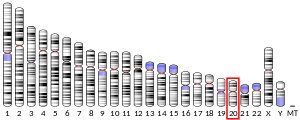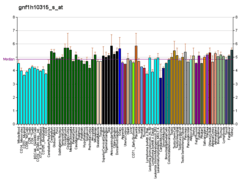Prokineticin receptor 2
Prokineticin receptor 2 (PKR2), is a G protein-coupled receptor encoded by the PROKR2 gene in humans.[5]
Function
Prokineticins are secreted proteins that can promote angiogenesis and induce strong gastrointestinal smooth muscle contraction. The protein encoded by this gene is an integral membrane protein and G protein-coupled receptor for prokineticins. The encoded protein is similar in sequence to GPR73, another G protein-coupled receptor for prokineticins.[5]
Mutations in the PROKR2 (also known as KAL3) gene have been implicated in hypogonadotropic hypogonadism and gynecomastia.[6]
gollark: All of them.
gollark: Great!
gollark: You can post it here or email me at osmarks@protonmail.com.
gollark: Okay, send me your browser history.
gollark: That too.
See also
References
- GRCh38: Ensembl release 89: ENSG00000101292 - Ensembl, May 2017
- GRCm38: Ensembl release 89: ENSMUSG00000050558 - Ensembl, May 2017
- "Human PubMed Reference:". National Center for Biotechnology Information, U.S. National Library of Medicine.
- "Mouse PubMed Reference:". National Center for Biotechnology Information, U.S. National Library of Medicine.
- "Entrez Gene: PROKR2 prokineticin receptor 2".
- Narula HS, Carlson HE (November 2014). "Gynaecomastia--pathophysiology, diagnosis and treatment". Nature Reviews. Endocrinology. 10 (11): 684–98. doi:10.1038/nrendo.2014.139. PMID 25112235.
Further reading
- Lin DC, Bullock CM, Ehlert FJ, Chen JL, Tian H, Zhou QY (May 2002). "Identification and molecular characterization of two closely related G protein-coupled receptors activated by prokineticins/endocrine gland vascular endothelial growth factor" (PDF). The Journal of Biological Chemistry. 277 (22): 19276–80. doi:10.1074/jbc.M202139200. PMID 11886876.
- Soga T, Matsumoto Si, Oda T, Saito T, Hiyama H, Takasaki J, Kamohara M, Ohishi T, Matsushime H, Furuichi K (December 2002). "Molecular cloning and characterization of prokineticin receptors". Biochimica et Biophysica Acta (BBA) - Gene Structure and Expression. 1579 (2–3): 173–9. doi:10.1016/S0167-4781(02)00546-8. PMID 12427552.
- Battersby S, Critchley HO, Morgan K, Millar RP, Jabbour HN (May 2004). "Expression and regulation of the prokineticins (endocrine gland-derived vascular endothelial growth factor and Bv8) and their receptors in the human endometrium across the menstrual cycle". The Journal of Clinical Endocrinology and Metabolism. 89 (5): 2463–9. doi:10.1210/jc.2003-032012. PMID 15126578.
- Pasquali D, Rossi V, Staibano S, De Rosa G, Chieffi P, Prezioso D, Mirone V, Mascolo M, Tramontano D, Bellastella A, Sinisi AA (September 2006). "The endocrine-gland-derived vascular endothelial growth factor (EG-VEGF)/prokineticin 1 and 2 and receptor expression in human prostate: Up-regulation of EG-VEGF/prokineticin 1 with malignancy". Endocrinology. 147 (9): 4245–51. doi:10.1210/en.2006-0614. PMID 16763065.
- Dodé C, Teixeira L, Levilliers J, Fouveaut C, Bouchard P, Kottler ML, Lespinasse J, Lienhardt-Roussie A, Mathieu M, Moerman A, Morgan G, Murat A, Toublanc JE, Wolczynski S, Delpech M, Petit C, Young J, Hardelin JP (October 2006). "Kallmann syndrome: mutations in the genes encoding prokineticin-2 and prokineticin receptor-2". PLOS Genetics. 2 (10): e175. doi:10.1371/journal.pgen.0020175. PMC 1617130. PMID 17054399.
External links
- GeneReviews/NCBI/NIH/UW entry on Kallmann syndrome
- "Prokineticin Receptors: PKR2". IUPHAR Database of Receptors and Ion Channels. International Union of Basic and Clinical Pharmacology.
This article incorporates text from the United States National Library of Medicine, which is in the public domain.
This article is issued from Wikipedia. The text is licensed under Creative Commons - Attribution - Sharealike. Additional terms may apply for the media files.




